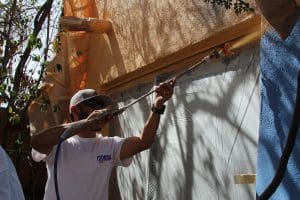
How Hot Is It?
Painting at just the right temperature and humidity is important to get a nice looking finished result. Here in Arizona, bitter cold is seldom an issue. At these temperatures paint has a tough time drying at all. However, extreme heat also influences paint.
Painting in excessive heat can be uncomfortable for the painter, but it is also not good for the paint. Too much heat can cause the surface of the paint to skin over well before the bottom layers have a chance to dry. Painting in extreme temperatures causes other issues as well.
If the temperature is too hot the paint will dry faster than normal. Bumps and blisters can form. Other imperfections can occur too. The paint can crack or become discolored. It may lift from the surface when it is overheated.
Temperature Rules
Types of paint have different properties that have an impact on drying characteristics. Oil-based paints should not be used if the temperature is going to be less than 45° or 7° C within a two-day time frame. Latex and acrylic paints should be used at temperatures above 50° or 10° C.
Painting in lower temperatures causes the paint to become thicker. The thicker coat of paint takes longer to dry. Oil-based paints take longer to oxidize in cooler temperatures. Cooler temperatures also mean that solvents will take longer to evaporate. Curing rates for paints are much slower in cool temperatures so you will need to be patient and wait at least 24 hours before applying a second coat.
Oil-based paints should not be applied when temperatures exceed 90° and latex and acrylic paints will have problems at temperatures above 85°. High temperatures can prevent the paint from binding correctly causing bumps, blisters, based, and cracks in the paint.
Check the forecast before beginning your painting project. You will need at least two good days to get the best results for your efforts. You want to paint in the right temperatures and you don’t want to encounter too much wind or any rain.
If the day is too windy, it can cause the paint to dry too fast. If this happens you may see imperfections in the finished product.
Rain can adversely affect any paint job. It is important that the surface you are painting is thoroughly dry. This will ensure a good bond. You also want to be sure that the paint will have at least 4-8 hours of drying time before it rains. Moisture too soon after painting will also affect the bond and cause imperfections. This means that you also need to be aware of the humidity to produce perfect results.
Humid Conditions and Paint
Paint has protective qualities that can become compromised when the humidity is high. Too much moisture in the air can cause surfactant leaching. This produces brown or white spots on the paint surface. Additionally, when it is damp, moisture gets into the semi-dried paint film.
Wood surfaces are particularly problematic when the humidity is high. The wood can absorb moisture from the air. When the paint is applied to the surface, the moisture in the wood can cause it to bubble and it can affect the paint’s ability to adhere to the wood. The paint can peel and bubble when the wood is not dry enough.
If you have ever tried to dry wet clothes on a humid day you understand how difficult it is for moisture to evaporate on such days. It is the same with painting. The moisture in the air makes it difficult for paint to dry completely because the water in the paint does not evaporate easily in high humidity.
When the paint is applied at lower temperatures in high humidity, condensation can occur on the surface of the paint. This is a recipe for trouble. When condensation affects the paint surface it becomes damaged. The paint may lift, it may not adhere properly and there can be a failure of over paint.
The water in the paint needs to dry as fast as, or faster than, the solvents in the paint. If this does not happen, you have a water-logged paint mess that will need to be redone. This is true with water and oil-based paints.
For optimal results, the painting should be completed when relative humidity is between 40-50%. While too much humidity is damaging to paint, you still want some to reach a well-calibrated drying time. Avoid painting when the humidity is 85% or more.
The experts at Arizona Painting Company can help you with any questions you may have about painting your home or business building. Contact us today for help with your painting needs.

